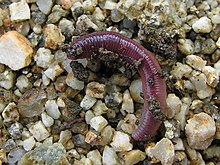Earthworm
An earthworm is an invertebrate animal with a long, stretchy body and no legs. It is a type of annelid.

There are 5,500 known species of earthworms in 21 families. They are found everywhere, except in polar or dry climates. Their sizes vary: they can be between two centimeters and about three meters in length. The biggest known earthworm is the giant Gippsland earthworm, found in Australia. It is usually about 80 cm in length, but can grow to about 3 meters.
The most common earthworm (in Europe, and most other temperate climate regions) grows to a size of about 20–25 cm when extended.
Most earthworms can regrow lost segments, assuming the worm has not had too much damage. This capability varies by species.
Long ago, all animals looking like worms were lumped together by John Ray and by Linnaeus in their classifications. Later, biologists found that some were in quite different groups. Roundworms and flatworms are different phyla. Inchworms are a type of caterpillar, and the slow-worm is a legless lizard.
Physical characteristics
changeThe average earthworm is a reddish brown color, with a pointed posterior and anterior end. There are no eyes or other discerning facial features, only a simply opening for a mouth. Earthworms have long, segmented bodies, covered in microscopic setae, or bristles, which help to anchor and pull the worm via longitudinal muscle contractions. Earthworms have no lungs, and absorb oxygen directly through their skin. In order to do this, they must stay moist, and do so by lubricating their skin with glands along their bodies.
Earthworms are invertebrates, lacking a skeleton. To support and shape the body, they are filled with coelomic fluid. Earthworms sometimes appear to have a "belt" or "saddle" around their bodies; this is a clitelum, a structure containing maturing eggs.
Earthworm habitats
changeEarthworms typically live in damp (but not wet), loose soil. They can also be found in loose leaf litter, and after it rains they can be found on the surface as they are forced out of the water-logged soil. Many gardeners welcome earthworms, as they aerate and enrich the soil with their droppings. They are also found in compost, feeding on decaying vegetable matter. An earthworm's burrow can be seen by the pile of dark, sand-like droppings, or casts, surrounding the entrance.
Reproduction
changeEarthworms are hermaphrodites, meaning they each contain male and female gametes. During mating, both worms exchange sperm and have eggs fertilized. The belt-like swollen area on the earthworm’s body, commonly called the "saddle" or "belt", is called a clitelum. It secretes a slimy substance that forms capsules which protect the eggs (sperm cells and eggs merge inside the capsule and form embryos). Inside, 1-20 eggs mature, taking between 60 and 90 days to hatch, depending on environmental factors such as humidity and temperature. An earthworm takes up to a year to fully mature, and in the wild they can live from 4 to 8 years.
Diet
changeThe typical earthworm diet is decaying matter, humus, leaf litter, microbial fungi, and other microscopic organisms. Earthworms are important to the environment, breaking down organic matter and passing it through their gut as newly enriched soil. An earthworm has no teeth, so it swallows grit to help grind food in its multi-chambered gut. As an earthworm burrows and feeds, it aerates the soil and adds nutrients from deeper soil layers to upper layers, making easier new plant growth in the process. For this reason, they are valued by farmers and gardeners worldwide.
Further reading
change- Llewellyn, Clair 2000. Earthworms. Watts, ISBN 0531146510
- Henwood, Chris 2005. Earthworms. Watts. ISBN 1932889205
- Kalman, Bobbie 2004. Earthworms. Crabtree. ISBN 0778-70696-6
- Darwin, Charles 1881: The formation of vegetable mould through the action of worms. London: Charles Murray.